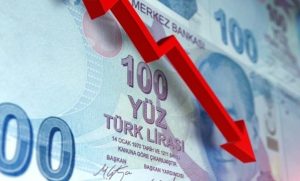The financial outlook for the Turkish Lira is a critical topic for investors, policymakers, and businesses alike. As the Turkish Lira (TRY) continues to experience fluctuations, understanding the potential declines and their implications is essential for making informed decisions. This article aims to provide a comprehensive analysis of the financial outlook for the Turkish Lira, examining factors that contribute to its volatility, possible future declines, and strategies to navigate these challenges.
The financial outlook for the Turkish Lira has been a subject of considerable concern in recent years. Turkey’s economy, influenced by various internal and external factors, has seen significant volatility in its currency. This article delves into the reasons behind these fluctuations and provides insights into potential future declines. By analyzing historical trends, current economic indicators, and expert forecasts, we can better understand what to expect from the Turkish Lira in the coming months and years.
To grasp the current financial outlook for the Turkish Lira, it’s crucial to understand its historical context. The Turkish Lira has experienced several periods of instability over the past decades. Economic crises, political instability, and global financial conditions have all played a role in shaping its trajectory. By examining past performance, we can identify patterns and potential warning signs of future declines.
Key Factors Influencing the Turkish Lira

Several factors influence the financial outlook for the Turkish Lira. These include:
- Economic Policies: Government policies, including fiscal and monetary measures, significantly impact the Lira’s value. Changes in interest rates, inflation targets, and budgetary policies can lead to fluctuations.
- Political Stability: Political events and instability can affect investor confidence and impact the Lira’s performance. Elections, geopolitical tensions, and policy changes are crucial factors to consider.
- Global Economic Conditions: The global economic environment, including trade relations, commodity prices, and financial market trends, can influence the Lira’s value. Changes in the US Dollar (USD) and Euro (EUR) exchange rates also play a role.
- Inflation Rates: High inflation erodes the purchasing power of the Lira, leading to a decline in its value. Monitoring inflation rates and inflationary pressures is essential for assessing the financial outlook for the Turkish Lira.
- Foreign Investment: The level of foreign direct investment (FDI) and portfolio investment in Turkey can impact the Lira. Increased investment often supports the currency, while capital outflows can contribute to declines.
Recent Trends and Current Economic Indicators

Examining recent trends and current economic indicators provides valuable insights into the financial outlook for the Turkish Lira. Recent data shows fluctuations in the Lira’s value, influenced by domestic and international events. Key indicators to monitor include:
- Exchange Rates: Tracking the Lira’s performance against major currencies like the USD and EUR helps assess its relative strength and weakness.
- Interest Rates: Changes in Turkey’s central bank interest rates impact the Lira’s attractiveness to investors. Higher rates can attract capital inflows, while lower rates may lead to declines.
- Inflation and Deflation: Monitoring inflation and deflation trends provides insights into the Lira’s purchasing power and potential future declines.
- Trade Balance: Turkey’s trade balance, including exports and imports, affects the Lira’s value. A trade deficit can put downward pressure on the currency.
Expert Forecasts and Predictions
Experts’ forecasts offer valuable perspectives on the financial outlook for the Turkish Lira. Analysts and economists provide predictions based on current trends, historical data, and economic models. While forecasts vary, common themes include:
- Short-Term Volatility: Many experts predict short-term volatility for the Lira due to ongoing economic uncertainties and geopolitical factors.
- Long-Term Trends: Long-term forecasts often depend on Turkey’s economic policies, structural reforms, and global economic conditions.
- Risk Factors: Identifying risk factors and potential triggers for declines is crucial for understanding future Lira performance. These may include external shocks, political instability, or economic imbalances.
Strategies for Managing Currency Risk

For businesses and investors, managing currency risk is essential when dealing with the financial outlook for the Turkish Lira. Effective strategies include:
- Hedging: Using financial instruments such as options and futures contracts can help hedge against currency risk. Hedging strategies should align with the entity’s risk tolerance and financial goals.
- Diversification: Diversifying investments across different currencies and assets can reduce exposure to Lira fluctuations. A diversified portfolio can help mitigate the impact of currency declines.
- Monitoring and Analysis: Regularly monitoring economic indicators, geopolitical events, and currency trends provides valuable insights for adjusting strategies and minimizing risk.
- Consultation with Experts: Seeking advice from financial experts and currency analysts can provide tailored strategies for managing currency risk. Experts can offer insights into market conditions and potential declines.
Case Studies: Impact of Currency Declines
Examining case studies of past currency declines can provide insights into the potential impact of future declines on the Turkish Lira. Case studies may include:
- Historical Crises: Analyzing historical currency crises, such as the 1994 Turkish financial crisis, can offer lessons on the effects of rapid declines and recovery strategies.
- Recent Events: Evaluating recent declines and their impact on businesses and investors helps understand the practical implications of Lira fluctuations.
Conclusion
The financial outlook for the Turkish Lira is shaped by a complex interplay of factors, including economic policies, political stability, and global conditions. Understanding the potential declines and their implications is crucial for making informed decisions. By examining historical trends, current indicators, expert forecasts, and effective risk management strategies, stakeholders can navigate the challenges and opportunities associated with the Turkish Lira.
Turkish Lira to USD Trend: Analyzing Recent Movements and Future Outlook
Turkish Lira Fluctuations: Best Financial Forecast and Predictions for 2024

